- Dug bed in backyard to left of maple, along wooden fence. Worked in coir/cocoa fiber, HollyTone, Hydrogel. X-planted Royal Fern + Ostrich Fern.
- TODO: X-Plant [to this same area under the maple]:
- Iris cristata
- Dryopteris marginalis
- Phlox stolonifera
- Planted Old House Gardens Dahlia "Union Jack" & Tuberose in Guy Wolff pots purchased last year.
- X-planted from front yard to South border:
- Campanula
- Coreopsis
- X-planted from pots to South border:
- Jerusalem artichoke
- Iris sibirica
- Baptisia?
- Planted seeds in South border:
- Nicotiana (various)
- Clary Sage
- Planted in vine bed:
- Moonvine (last weekend)
- Scarlet runner bean
2006-05-14
Garden Diary, May 12-14, 2006
2006-04-30
Garden Diary, April 30, 2006: Four Gardens Revisited, and the Backyard Garden
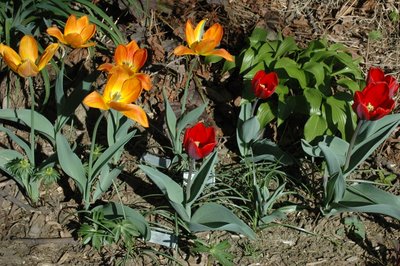
Photo Taken: April 21, 2006
It's our first full Spring in our house, in our neighborhood. Trees have been in flower for months now, it seems. Dogwoods are in bloom now. And we're just coming into the riot of forsythia and azalea.
There were the first snowdrops, the first crocus, the first signs of irreversible Spring. In our front garden, eranthis, crocus, and now, still, the longest-blooming tulips I've ever seen, heirloom/antique bulbs all.
As always, my understanding of what the gardens want and need has evolved over the past year. Here's my current plan:
- Front: heirloom/antique garden, all plants available 1905 or earlier
- North: Shady path
- South: "wild" garden, plants which seed themselves, mixed border, the "rough" garden
- Back: the native garden and wildlife sanctuary

This spot is visible from the driveway on the south of the house, and from the street along the north side of the house. Placing two large shrubs will block these lines of sight, providing privacy from without, and enclosing the views from within. The new lines of sight from/to the swing, constrained by the mature shrubs, are shown on the sketch.
2006-03-28
Garden Diary, March 28, 2006: The Porch Vine Bed
[Written while waiting for and riding subway into the city.]
...
I planted seeds today. Actually, the planting was the smallest part of what I did today, but it was the excuse for all I did. Last weekend I cleared all the ivy from the side porch. Today I sifted all the leaf mold and broke up the soil in the narrow strip between the porch foundation and the driveway. Finally, eventually, I planted the sweet pea seeds I started soaking last night before I went to bed. I moved the leaf mold and dirt from the tarp I'd set up on the driveway to the backyard.
I was exhausted. I moved a log to contain one of the new beds I'd just created, reset the adirondack chairs, the ones I'd built ... from kits at the apartment [Garden #3 in Park Slope], and collapsed into one of them.
I was too tired to move. For this I was rewarded. Not only did the bird feeder, just 10' from me, continue [ended abruptly for subway transfer.]
2005-10-15
Field Trip, October 15, 2005: New York State Sheep & Wool Festival
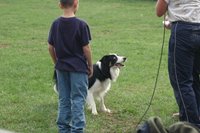
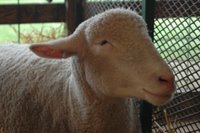
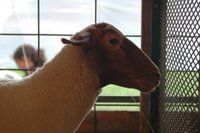
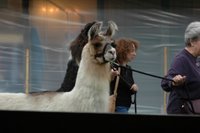



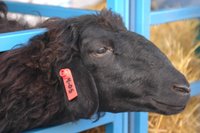
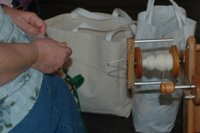

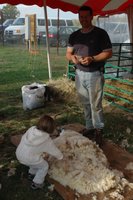
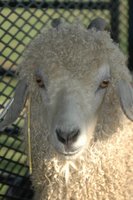
2005-07-24
Notes from a visit to the Brooklyn Botanic Garden, Late July 2005
[From the Compositae/Daisy Family Garden]
Silphium perfoliatum: Large: 6'H x 5'W (supported). Large leaves.
Liatris pycnostachya: 2' tall
L. spicata: 3-4' tall
Helianthus giganteus
Epilobium augustifolium [Chamerion angustifolium, Fireweed, Onagraceae]
Unidentified "weed": ~2-3' tall, leaves opposite, cordate, fuzzy, flowers yellow, 3 petals/sepals
Begonia grandis
[In the Native Flora Garden, I was noting plants which could work in my backyard native plant garden. Several of those listed are plants I grew in the widlflower bed in Garden #1 in the East Village.]
Native Flora Garden
*=blooming
Solidago rugosa
*Allium cernuum
*Dicentra eximia
*Eupatorium fistulosum: 8' tall
Viola pubescens
Vaccinium corymbosum
*Lilium superbum: 8' tall
Polemonium reptans
*Lysimachia ciliata
Polygonatum biflorum
Sanguinaria canadensis
Asarum canadense
Viola striata (same as home?)
Hepatica acutiloba
*Cimicifuga racemosa: 5-6' tall, fragrant
*Allium tricoccum (blooming w/out leaves)
Opuntia humifusa
2005-07-15
Garden Diary, July 2005: Envisioning the Fourth Garden
We moved into our new house about six weeks ago, the last Thursday in May. This will be my fourth garden in New York City since I moved here 26 years ago, in the Winter of 1979.
House and garden have both been neglected. Both are in need of maintenance, repair, and loving back to their full flower. Both will need work, time, patience, investment. I can envision the trajectories and futures of both.
Particularly, I can imagine bringing the house and garden(s) back together. Each want the other, each need the other. In time, the house will become part of the gardens, grwing out of them, sheltering them, providing the largest bones in the architecture of the garden.
And the house will change to fit and frame the gardens. The siding will be returned to its original design of clapboard and shingle, though how many years and $10K it will take I shudder to comprehend. In longer time, the back will be returned, I believe, to an open porch, the kitchen expanded and opened up to blur the boundary between indoor and outdoor space, between house and garden, between the manufactured and the spontaneous.
Vines will climb up the sides of the screened porches, screening and sheltering them further, filling the porches with fragrance, filtered light, luminous color. Mature shrubs will shade the south side of the house in summer, and draw birds to their berries and hold the snow in winter. Flowers and foliage will spill from window boxes and containers ankling the paths, forcing one to stop to inspect, to smell, to feel, to slow down.
I can see all this as it will be, as it's coming to be.
2005-06-22
Garden Notes, June 22, 2005: Envisioning the Backyard Garden, Four Gardens
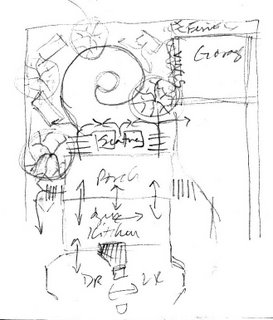
Four Gardens:
- Front: Heirloom/Cottage
- North: Shade/Path
- South: Shrub Border, Wild Garden
- Back: Sanctuary, Native, Habitat
2005-06-17
Garden (and more) Diary, June 17, 2005: The Fourth Garden, Four Gardens
My good deed for the day: Letting a fat man on the subway know his fly is open.
I can relate. I've done the same in the past week. It's not easy for a fat man to be aware of his appearance below the chest. Easier, more comfortable, to stay in the head. There I can be as thin as I remember I was.
John and I bought a house. I've written nothing for so long. Major events like that can just slip by without notice. It's a big house. So far, it's too big for the two of us. And it needs lots of work. I'm trying to do a little each day, but it's hard.
Got off the R at Rector Street. Now sitting on a bench in the graveyard of Trinity Church. "Here lies ..." "Sacred to the memory of ..." Even the bench is worn, low to the ground. To remind us, I guess.
I like to walk through here on the way to work. From our new home, my commute offers more opportunities to do so. Reminders of impermanence to help me keep work in perspective.
The gardens here - the cemetery is a garden - are simple and beautiful. Massive hostas, irises, past bloom. Daylilies, clouds of them, in fat green buds, just about to announce summer.
I'm starting my fourth garden in New York City. Some day it will be on the Victorian Flatbush House & Garden Tour, probably years before the house itself is. I can aim for 2008, the year of my 50th, three years away.
There are at least four gardens to be developed: two sides, the front, and back. All have something different to offer. Each can welcome visitors in its own way. All will relate to the house, and relate the house to the grounds. It's already happening, as I come to understand the house and what it wants.
Well, off to work ...
2005-06-15
Garden Notes, June 15, 2005: Plants for the Native Garden
- Cercis canadensis, Redbud
- Hydrangea quercifolia "Little Honey", Oak-Leaf Hydrangea cultivar
- Lonicera sempervirens, Trumpet Honeysuckle
- Ilex verticillata, Winterberry
- Viburnum (native species)
- Cornus canadensis, Bunchberry
- Arctostaphylos uva-ursi, Bearberry
- Gaultheria procumbens, Wintergreen
- Rhododendron (native species)
- Kalmia latifolia, Mountain Laurel
- Prunus (native species)
- Rosa carolina, Pasture Rose (possible other native species)
- Trillium
- Arisaema triphyllum, Jack-in-the-Pulpit
- Viola (native species)
- Asarum canadense, Wild Ginger
- Lilium (native species)
- Solidago (native species)
- Lobelia (native species)
- Mertensia virginica, Virginia Bluebells
- Hepatica acutiloba, Sharp-lobed Liverwort
- Aster (native species)
2001-10-15
Without God
October 15, 2001
An open letter to Joanna Tipple, pastor of the Craryville and Copake Churches in New York State.
Dear Joanna:
Sorry I missed you when you came to the city to deliver the bears. I've been wanting to write you. I've found it hard to write at all. There are no words.
I want to thank you and the congregations of the Craryville and Copake churches for welcoming me at your services that first Sunday after September 11. While it may have helped to be the preacher's wife, I know there was more to it than that! It was comforting to feel held there, knowing that John and I had to return to our homes in New York City that afternoon. I didn't know what we'd be returning to. I wept during both services. I've wept a lot since.
I work two blocks from where the towers were. I've seen it from the street, from the roof of my office building, from our lunch room twenty-seven floors up. I try to approach my presence in the city at this time as a naturalist, observing and recording changes in the physical environment and the behavior of its inhabitants. I want to remain present without withdrawing, so I can bear witness.
The fires still burn. Smoke still scents the surrounding streets and buildings. While rain has rinsed most of the gutters, ash still coats statues, windows and rooftops. In low and sheltered areas, the rain and ash mixed with shredded documents from the towers to create a gray papier mache. The "Missing Person" posters - and only those closest to them held any hope they would be "found" - and sidewalk memorials of candles and the poetry of anguish, rage, and hope, are slowly eroding.
I've been thinking a lot about something you said during one of your sermons that Sunday. I think it was at the Copake service, while speaking to the shock and terrible loss of the preceding week, you said something like "I don't know how someone could get through this without God." I heard this as a question. I want to respond. I want to give something back to you and the congregations. For myself, once again I must make sense of senseless loss.
The Friday after John and I got back to the city was my first visit back to my office, and downtown. Power had been restored to our buildings and some of us went in to ready our offices and equipment for our colleagues' return that Monday, two weeks after the attacks. My colleagues and I hugged when we saw each other. In a conversation that day with one of our vice presidents, she observed "Nothing is permanent, except God." What struck me was that she seemed to be realizing this for the first time.
Nothing lasts. Not the smoke and ash, not the wreckage of the towers, not even our grief or the memorials we will erect. Everything that is, all we experience, survive, and celebrate, occurs without God. Nothing is always. This makes it all the more mysterious, not less, all the more wonderful, precious and beautiful.
Most of my twenty-three years in New York City I've been surrounded, touched, by death. Death from AIDS. Death from suicide. Death from overdose. The slow deaths of addiction, of abuse. I do not consider death a friend, but it is not my enemy. It is familiar to me. I have grieved, and grieved again, and more, and each new loss touches all the others through me. Through countless repeated uses over the years, my grief has become burnished, polished through use like a favorite tool. Comfortable to hold. Fitting my hand. Perfectly balanced for the task. I can pick it up when I need to. I can set it down when this work is done.
In the past I've described myself as a rabid atheist. John has known me a long time and can attest to the accuracy of this assessment. I've mellowed somewhat over the years, but nothing in my experience has yet to dissuade me from my fundamental disbelief. By the age of ten I realized that what was being taught to me as the Word of God was simply wrong. Not wrong as in incorrect, but immoral, unethical, unjust. The vision of heaven conveyed to me was no place I'd want to be. The God I was supposed to worship was nothing I could respect. Growing up gay in a world rife with homophobic cultures didn't change my disbelief. If I were to believe so-called religious leaders, my love is an abomination, my kind deserving of extermination. There seems little point to believing in any of their hateful Gods.
Again, and still, horrors are committed in the name of God. A month ago, more than five thousand people lost their lives in a smoking crater, killed in the name of God. It makes no difference to me whether the banner reads "Holy War" or "God Bless America." This crisis has brought out both the best and worst in people. Like any tool, the idea of God is used for evil as well as good. Then what good is God?
A problem with the word "atheist" is that it simply means "without god." The word doesn't summon anything new. It doesn't suggest any alternatives. It doesn't address your question. It's as useless and inadequate as "non-white." There are within me other beliefs, moral convictions, even something I am sometimes willing to call spirituality, which transcend God.
As I tend my garden, I recall how it was a minute, a day, a year ago. That flower was, or was not, blooming yesterday. This plant has grown over the years and now crowds its neighbors. A label in the ground shows where another plant has vanished. Should I replace it, or try something new? I weed. I plant. I water. I sit. The garden asks me to see it as it really is, not just how I remember it, or how I wish it to be. Gardening continues to teach me many lessons. Gardening is my prayer.
So I must be in the world. Remembering what was. Observing what is. Hoping for what can be. Acting to bring it into being. When we struggle to understand, we question what is. Science can ask, and eventually answer, "What?" and "How?" It cannot answer the one question that matters, the question for which Man created God: "Why?" Now, as with each new loss, I ask again: Why am I here? Why am I alive?
The only answer I've come across which satisfies me at all comes from Zen: The purpose of life is to relieve suffering. Not to relieve pain, or grief, or loss. These cannot be avoided. But to relieve suffering, which we ourselves bring into the world. Because death is senseless, the only sense to be found is that which we manifest in our own lives. The only meaning there can be in life is what we impart.
Or, as someone else might say, the kingdom of god is within each of us.
[bit.ly]
